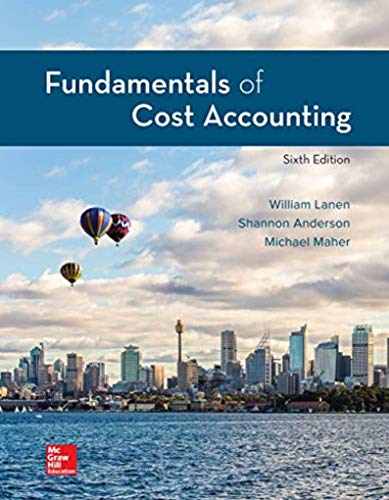
a.
Prepare a production cost report using the weighted-average method.
a.
Explanation of Solution
Weighted average cost method:
Weighted average cost method is the method to find out the equivalent units in the
Compute the total units for materials, labor and
| Particulars | Physical units | Materials | Labor | Overhead |
| Beginning work-in-process inventory | 80,000 | |||
| Units started this period | 400,000 | |||
| Total units | 480,000 | |||
| Completed and transferred out | ||||
| Beginning work-in-process inventory | 80,000 | |||
| Started and currently completed | 280,000 | |||
| Total transferred out | 360,000 | 360,000 | 360,000 | 360,000 |
| Units in ending work-in-process inventory | 120,000 | 120,000 | 48,000(1) | 48,000 (2) |
| Total units | 480,000 | 480,000 | 408,000 | 408,000 |
Table: (1)
Compute the cost per equivalent for materials, labor and overhead:
| Particulars | Total | Materials | Labor | Overhead |
| Costs in beginning work-in-process inventory | $ 1,222,800 | $ 240,000 | $ 546,000 | $ 436,800 |
| Current period costs | $ 5,534,400 | $ 1,560,000 | $ 2,208,000 | $ 1,766,400 |
| Total costs | $ 6,757,200 | $ 1,800,000 | $ 2,754,000 | $ 2,203,200 |
| Cost per equivalent unit | ||||
| Materials | $ 3.75(3) | |||
| Labor | $ 6.75(4) | |||
| Overhead | $ 5.40(5) |
Table: (2)
Compute the total costs of materials, labor and overhead:
| Particulars | Total | Materials | Labor | Overhead |
| Transferred out: | ||||
| Materials | $ 1,350,000 | $ 1,350,000(6) | ||
| Labor | $ 2,430,000 | $ 2,430,000(7) | ||
| Overhead | $ 1,944,000 | $ 1,944,000(8) | ||
| Total costs | $ 5,724,000 | |||
| Work-in-process ending inventory | ||||
| Materials | $ 450,000 | $ 450,000(9) | ||
| Labor | $ 324,000 | $ 324,000(10) | ||
| Overhead | $ 259,200 | $ 259,200(11) | ||
| Total ending work-in-process inventory | $ 1,033,200 | |||
| Total costs | $ 6,757,200 | $ 1,800,000 | $ 2,754,000 | $ 2,203,200 |
Table: (3)
Working note 1:
Compute the units in ending work-in-process inventory:
Working note 2:
Compute the units in ending work-in-process inventory:
Working note 3:
Compute the cost per equivalent unit:
Working note 4:
Compute the cost per equivalent unit:
Working note 5:
Compute the cost per equivalent unit:
Working note 6:
Compute the costs assigned to units transferred out:
Working note 7:
Compute the costs assigned to units transferred out:
Working note 8:
Compute the costs assigned to units transferred out:
Working note 9:
Compute the costs assigned to ending work-in-process inventory:
Working note 10:
Compute the costs assigned to ending work-in-process inventory:
Working note 11:
Compute the costs assigned to ending work-in-process inventory:
b.
Show the
b.
Explanation of Solution
Journal entries:
It is the important part of accountancy. A journal entry consists of recording which is either a debit or credit. The total of both debit and credit must be equal.
Compute the difference between the correct computation and the information given in the statement:
| Particulars | Work-in-process | Finished goods |
| As per statement | $ 793,152 | $ 337,560 |
| Correct | $ 1,033,200 | $ 318,000 |
| Difference | ($ 240,048) | $ 19,560 |
Table: (4)
Journal entry of passing the correctly computed information:
| Particulars | Post Ref. | Debit | Credit |
| Work-in-process | $ 240,048 | ||
| Finished goods | $ 19,560 | ||
| Cost of goods sold | $ 220,488 |
Table: (5)
Working note 12:
Compute the correct value of finished goods:
c.
Determine the effect of adjustment not being made with respect to inventories being overstated or understated.
c.
Explanation of Solution
If the adjustments are not made with respect to inventories being overstated or understated the following effects will appear on the costing of the process:
- • Finished goods would have remained overstated.
- • Work-in-process would have remained understated.
- • Income would have remained understated.
Want to see more full solutions like this?
Chapter 8 Solutions
Fundamentals Of Cost Accounting (6th Edition)
- I need help with this financial accounting problem using accurate calculation methods.arrow_forwardPlease provide answer this general accounting questionarrow_forwardPremier Lighting Co. shows Merchandise Inventory of $35,000. Based on a count taken on December 31, merchandise inventory at the end of the year actually totaled $28,000. The adjusting entry to remove the old merchandise inventory balance would be: A)a debit to Income Summary of $28,000 and a credit to Merchandise Inventory for The adjusting entry to remove the old merchandise inventory balance would be:arrow_forward
- Can you help me solve this general accounting problem using the correct accounting process?arrow_forwardI am searching for a clear explanation of this financial accounting problem with valid methods.arrow_forwardPlease explain the correct approach for solving this general accounting question.arrow_forward
 Principles of Cost AccountingAccountingISBN:9781305087408Author:Edward J. Vanderbeck, Maria R. MitchellPublisher:Cengage LearningPrinciples of Accounting Volume 2AccountingISBN:9781947172609Author:OpenStaxPublisher:OpenStax College
Principles of Cost AccountingAccountingISBN:9781305087408Author:Edward J. Vanderbeck, Maria R. MitchellPublisher:Cengage LearningPrinciples of Accounting Volume 2AccountingISBN:9781947172609Author:OpenStaxPublisher:OpenStax College Intermediate Accounting: Reporting And AnalysisAccountingISBN:9781337788281Author:James M. Wahlen, Jefferson P. Jones, Donald PagachPublisher:Cengage Learning
Intermediate Accounting: Reporting And AnalysisAccountingISBN:9781337788281Author:James M. Wahlen, Jefferson P. Jones, Donald PagachPublisher:Cengage Learning Managerial AccountingAccountingISBN:9781337912020Author:Carl Warren, Ph.d. Cma William B. TaylerPublisher:South-Western College Pub
Managerial AccountingAccountingISBN:9781337912020Author:Carl Warren, Ph.d. Cma William B. TaylerPublisher:South-Western College Pub Cornerstones of Cost Management (Cornerstones Ser...AccountingISBN:9781305970663Author:Don R. Hansen, Maryanne M. MowenPublisher:Cengage Learning
Cornerstones of Cost Management (Cornerstones Ser...AccountingISBN:9781305970663Author:Don R. Hansen, Maryanne M. MowenPublisher:Cengage Learning




